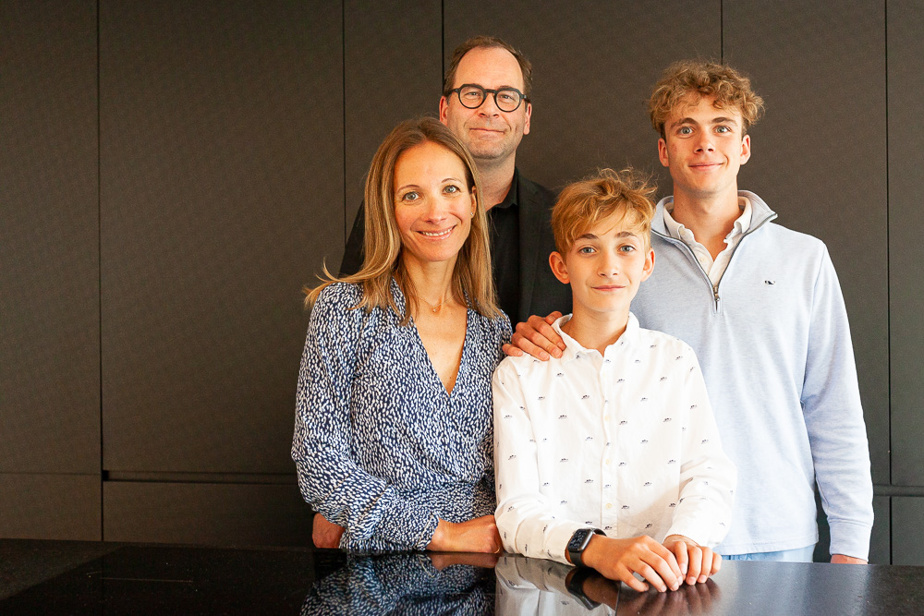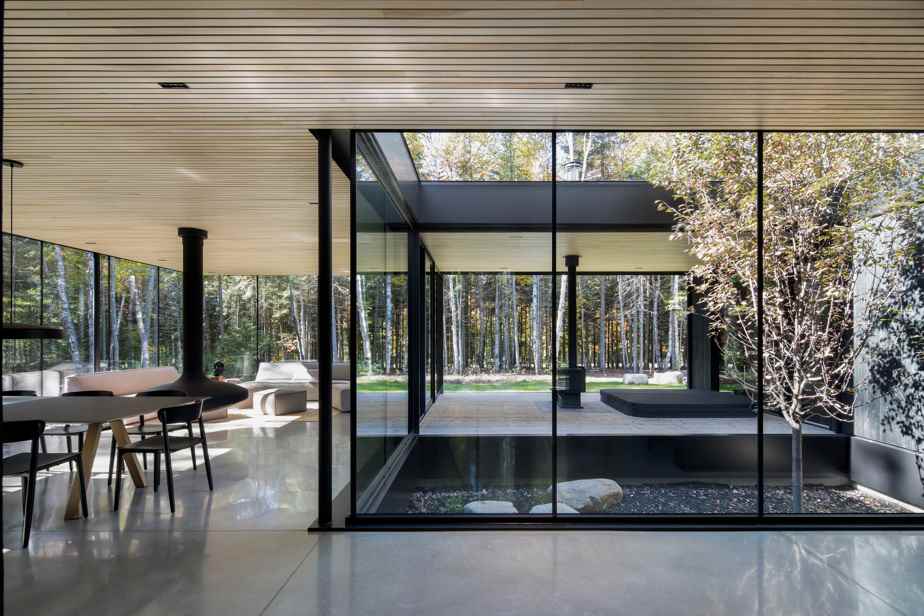Trees blown by the storm litter the road leading to Saint-Donat. At their destination, 50 windswept behemoths wait to be torn to pieces. The little apple tree has remained intact, nestled in the heart of a house of which it has become the focal point.
Posted at 12:00 p.m.
From his native Montérégie, the architect Maxime-Alexis Frappier keeps the comforting memory of the farm, the chicken coop and 5000 apple trees spread over 100 acres of fertile and domesticated land. A canvas very different from the untamed landscapes of the North to which he nevertheless ended up becoming attached over the years. Her sweetheart grew up in this topography of mountains, lakes and spruce trees where her parents had a cottage for a long time before settling full-time on the shore of Lake Archambault.
The charm of the enveloping cross-country ski trails, the village ice rink, the immense expanse of water on which to practice sailing and the warm presence of the in-laws ended up getting the better of the guy from the South Shore. After years of renting in the area, Maxime-Alexis Frappier acquired the land adjacent to that of his parents-in-law, but in the forest, with the intention of building a house connected to its green setting.

PHOTO KARENE-ISABELLE JEAN-BAPTISTE, special collaboration
Architect Maxime-Alexis Frappier, his wife Marie-Andrée Lahaie and their two sons, William and Arthur
At the heart of this residence, a tree foreign to the landscape is flowering — a fragment of imported memory: a boy running through an orchard in Hemmingford… It is around this apple tree that the U-shaped house is articulated, the three main blocks of which have doors -overhangs are reminiscent of farm buildings. Each has its function: the living areas and the garage on one side; on the other, two blocks which include the parental suite and the teenagers’ wing.
The anxiety of creation
When the design of this residence began in 2019, the French architect Roger Taillibert – the friend, the master – was spending his last moments of life. “He was the one who helped me take a step back from my practice. He always told me that the first duty of the architect is to create emotion. Taillibert achieved this in particular through the use of curves. And that’s where Maxime-Alexis Frappier drew inspiration for his first sketches.
“Initially, I created a round house, but the project did not pass to the family committee, he says, laughing. My wife’s wisdom brought me back to practical considerations: where will the furniture go in this kind of space and how much will it cost? »

PHOTO PROVIDED BY ACDF
A terrace adjacent to the inner courtyard is screened as needed with hinged blinds. This hybrid space between the interior and the exterior creates the bridge between the residential blocks in continuity with the interior and contributes to blurring the boundaries.
So the architect went back to his drawing board. From sketch to sketch, he found emotion with this minimalist and graphic concept, evolving around an interior courtyard which acts as a huge skylight. In this visual breakthrough, the sun wanders from morning to evening to bathe the kitchen in amber light at the end of the day. The moon then appears there and gives way to a starry sky. Unlike the glass block in the living areas, which showcases the base of the trees, the central opening allows you to see the tops dancing. It is in this opening that his apple tree takes root. The space vibrates. Pulses.
We are in a dense forest. We better understand the importance of each tree when we adopt one.
Maxime-Alexis Frappier, architect and founder of the firm ACDF
“As an architect, it’s really exciting to make your house. And just as anxiety-provoking, he says, admitting to having felt the pressure to prove himself and to stand out with this personal creation. “While doing this, I was designing a 42-story tower in Vancouver, but the anxiety I had with my house was living in a design that would mark a very specific moment in my career. »
“To alleviate my anxiety about doing something that was going to go out of fashion, I revisited the main principles of composition with which you can’t go wrong. Like the painter, he worked on the superposition of layers, the play of contrasts and transparency that create depth and interest. Upon entering, the visitor discovers this multi-layered space — the airlock, the central opening, the terrace, the forest. The boundaries between nature and the outside are blurred.
Getting back to basics
The couple wanted a bungalow with a fully glazed space allowing them to connect with nature. The transparency effect has been concentrated in the axis of the living room. “It feels like being outdoors like camping. It’s a space that makes you want to chat with others, to read…”, stresses Marie-Andrée Lahaie. “And to do something other than watch TV,” continues William, the eldest of the two boys.
-

PHOTO PROVIDED BY ACDF
The fully glazed space allows you to connect with nature. The transparency effect has been concentrated in the axis of the living room.
-

PHOTO PROVIDED BY ACDF
The fully glazed space allows you to connect with nature. The transparency effect has been concentrated in the axis of the living room.
1/2
To manage to create an entirely glazed space in the living area and the circulation spaces, the architect saved on windows in the bedrooms. To reduce costs, he made do with the existing construction constraints. The ceiling adopts a height of 9 ft, like the large windows which are in the industry standards. The bathrooms and kitchen are unadorned and the rooms are of reasonable size.
“We wanted a house where we could all be together and see each other, but still have privacy. Together or apart, we are visually in contact. And to be more isolated, we retire to our bedrooms,” emphasizes the designer, whose house has been a small creative laboratory and an opportunity to push certain concepts within budget limits. A question also accompanied the process and served as a parameter for creation: do we really need it?
“The pressure was great. But I’m really happy with what we did. I think that in the end, it’s a fine example of the reasonable use of resources to create spaces where you feel good,” concludes Maxime-Alexis Frappier. The small apple tree is home to wildlife, gives the pulse of the temperature, changes with the seasons… “We have the impression that this tree accompanies us on a daily basis. I believe it is this relationship between nature and humans that makes me happiest. »

